Bath: Difference between revisions
No edit summary |
|||
| Line 18: | Line 18: | ||
Bath is 13 miles south-east of [[Bristol]]. It was granted the title "City" by Queen Elizabeth I in 1590.<ref name="bath_insignia">{{cite web |url=http://www.thecityofbath.co.uk/civic_insignia.htm |title=Civic Insignia |accessdate=10 December 2007 |work=City of Bath }}</ref> | Bath is 13 miles south-east of [[Bristol]]. It was granted the title "City" by Queen Elizabeth I in 1590.<ref name="bath_insignia">{{cite web |url=http://www.thecityofbath.co.uk/civic_insignia.htm |title=Civic Insignia |accessdate=10 December 2007 |work=City of Bath }}</ref> | ||
The city was first established as a spa with the Latin name, ''Aquae Sulis'' ("the waters of Sulis") by the Romans in 43 | The city was first established as a spa with the Latin name, ''Aquae Sulis'' ("the waters of Sulis") by the Romans in AD 43, although verbal tradition suggests that Bath was known before then.<ref>{{cite web | url=http://visitbath.co.uk/site/spa-and-wellbeing/history-of-baths-spa |title=History of Bath's Spa |publisher=Bath Tourism Plus | accessdate=25 January 2011}}</ref> They built baths and a temple on the surrounding hills of Bath in the valley of the [[River Avon, Somerset|River Avon]] around natural hot springs.<ref name="worldheritageplan"/> | ||
Bath was a chief city of the realm in the early Middle Ages; the grand coronation of King Edgar I took place here in 973, and at a Witan here in 1086 William the Conqueror ordered the [[Domesday Book|Domesday Survey]]. Much later, it became popular as a spa town during the Georgian era, which led to a major expansion that left a heritage of exemplary Georgian architecture crafted from Bath Stone. | Bath was a chief city of the realm in the early Middle Ages; the grand coronation of King Edgar I took place here in 973, and at a Witan here in 1086 William the Conqueror ordered the [[Domesday Book|Domesday Survey]]. Much later, it became popular as a spa town during the Georgian era, which led to a major expansion that left a heritage of exemplary Georgian architecture crafted from Bath Stone. | ||
| Line 45: | Line 45: | ||
The Roman Bath, uncovered and restored, still receives though it ancient channels, the hot water of the spring and forms a centre-piece of the town. The entire structure above the level of the pillar bases is a later reconstruction, but the bath is original. | The Roman Bath, uncovered and restored, still receives though it ancient channels, the hot water of the spring and forms a centre-piece of the town. The entire structure above the level of the pillar bases is a later reconstruction, but the bath is original. | ||
The Romans built the temple of Sulis Minerva in 60–70 | The Romans built the temple of Sulis Minerva in AD 60–70 and the bathing complex was gradually built up over the next 300 years.<ref name="worldheritageplan">{{cite web |url=http://www.bathnes.gov.uk/worldheritage/2.3Des.htm |title=City of Bath World Heritage Site Management Plan |accessdate=1 November 2007|work=Bath and North East Somerset |archiveurl=http://web.archive.org/web/20070614100836/http://www.bathnes.gov.uk/worldheritage/2.3Des.htm |archivedate=14 June 2007}}</ref> | ||
The first work on the baths was possibly during the reign of the Emperor Claudius, in whose time the Romans had come to Britain.<ref>{{cite web |url=http://www.plumbingworld.com/historyroman.html |title=The History of Plumbing — Roman and English Legacy |accessdate=1 November 2007 |work=Plumbing World }}</ref> Engineers drove oak piles into the mud to provide a stable foundation and surrounded the spring with an irregular stone chamber lined with lead. In the 2nd century, the spring was enclosed within a wooden barrel-vaulted building,<ref name="somersettourguide"/> which housed the ''calidarium'' (hot bath), ''tepidarium'' (warm bath), and ''frigidarium'' (cold bath).<ref name="timetravel">{{cite web |url=http://www.timetravel-britain.com/articles/stones/romanbaths.shtml |title=The Roman Baths |accessdate=21 November 2009 |work=TimeTravel Britain }}</ref> | The first work on the baths was possibly during the reign of the Emperor Claudius, in whose time the Romans had come to Britain.<ref>{{cite web |url=http://www.plumbingworld.com/historyroman.html |title=The History of Plumbing — Roman and English Legacy |accessdate=1 November 2007 |work=Plumbing World }}</ref> Engineers drove oak piles into the mud to provide a stable foundation and surrounded the spring with an irregular stone chamber lined with lead. In the 2nd century, the spring was enclosed within a wooden barrel-vaulted building,<ref name="somersettourguide"/> which housed the ''calidarium'' (hot bath), ''tepidarium'' (warm bath), and ''frigidarium'' (cold bath).<ref name="timetravel">{{cite web |url=http://www.timetravel-britain.com/articles/stones/romanbaths.shtml |title=The Roman Baths |accessdate=21 November 2009 |work=TimeTravel Britain }}</ref> | ||
| Line 93: | Line 93: | ||
The early 18th century saw Bath acquire its first purpose-built theatre, the Old Orchard Street Theatre, which was rebuilt as the Theatre Royal, the along with the Grand Pump Room attached to the Roman Baths and Bath Assembly Rooms. Master of Ceremonies Beau Nash, who presided over the city's social life from 1705 until his death in 1761, drew up a code of behaviour for public entertainments.<ref>{{cite book |title=The Imaginary Autocrat: Beau Nash and the invention of Bath |last=Eglin |first=John |year=2005 |publisher=Profile |isbn=978-1-86197-302-3 }}</ref> | The early 18th century saw Bath acquire its first purpose-built theatre, the Old Orchard Street Theatre, which was rebuilt as the Theatre Royal, the along with the Grand Pump Room attached to the Roman Baths and Bath Assembly Rooms. Master of Ceremonies Beau Nash, who presided over the city's social life from 1705 until his death in 1761, drew up a code of behaviour for public entertainments.<ref>{{cite book |title=The Imaginary Autocrat: Beau Nash and the invention of Bath |last=Eglin |first=John |year=2005 |publisher=Profile |isbn=978-1-86197-302-3 }}</ref> | ||
The great works of this time include the Royal Crescent (by John Wood the Younger), the Circus (John Wood the Elder), Lansdown Crescent (John Palmer), the Assembly Rooms (John Wood the Younger), the Pump Room (Thomas Baldwin / John Palmer), Pultney Bridge (Robert Adam), the theatres and much else besides. | The great works of this time include the Royal Crescent (by John Wood the Younger), the Circus (John Wood the Elder), Lansdown Crescent (John Palmer), the Assembly Rooms (John Wood the Younger), the Pump Room (Thomas Baldwin / John Palmer), [[Pultney Bridge]] (Robert Adam), the theatres and much else besides. | ||
This new-built Georgian town was the Bath was that so beloved of Jane Austen and the characters in her books, a connection the town never tires of celebrating: | This new-built Georgian town was the Bath was that so beloved of Jane Austen and the characters in her books, a connection the town never tires of celebrating: | ||
| Line 158: | Line 158: | ||
*Roman Baths<ref>{{cite web | title=Roman Baths Treatment Centre | work=Images of England | url=http://www.imagesofengland.org.uk/Details/Default.aspx?id=442194 | accessdate=15 November 2006}}</ref> | *Roman Baths<ref>{{cite web | title=Roman Baths Treatment Centre | work=Images of England | url=http://www.imagesofengland.org.uk/Details/Default.aspx?id=442194 | accessdate=15 November 2006}}</ref> | ||
*Holburne Museum of Art,<ref>{{cite web | title=Holburne of Menstrie Museum | work=Images of England | url=http://www.imagesofengland.org.uk/Details/Default.aspx?id=443742|accessdate=15 November 2006}}</ref> | *Holburne Museum of Art,<ref>{{cite web | title=Holburne of Menstrie Museum | work=Images of England | url=http://www.imagesofengland.org.uk/Details/Default.aspx?id=443742|accessdate=15 November 2006}}</ref> | ||
*Bath Postal Museum | |||
*Fashion Museum | *Fashion Museum | ||
*Jane Austen Centre | *Jane Austen Centre | ||
| Line 235: | Line 235: | ||
The '''Roman Baths''' are the foremost of the archaeological sites in the city centre representing that period. They are reconstructed above the leve of the baths theselves but the most important parts of the baths are original. | The '''Roman Baths''' are the foremost of the archaeological sites in the city centre representing that period. They are reconstructed above the leve of the baths theselves but the most important parts of the baths are original. | ||
'''Bath Abbey''' was a Norman church built on earlier foundations, though the present church is early 16th century. The walls of Bath Abbey are crammed full with memorials to those of the gentry who came to Bath for a cure, and who are buried here. | '''[[Bath Abbey]]''' was a Norman church built on earlier foundations, though the present church is early 16th century. The walls of Bath Abbey are crammed full with memorials to those of the gentry who came to Bath for a cure, and who are buried here. | ||
'''Georgian architecture''' is dominant in central Bath, built of honey-colorued Bath Stone hewn from local hills. Many of the prominent architects of the day were employed in the development of the city. The original purpose of much of Bath's architecture is concealed by the honey-coloured classical façades; in an era before the advent of the luxury hotel, these apparently elegant residences were frequently purpose-built lodging houses, where visitors could hire a room, a floor, or (according to their means) an entire house for the duration of their visit, and be waited on by the house's communal servants.<ref>{{cite book |title=Social Decline and Slum Conditions: Irish migrants in Bath's History |accessdate=12 December 2007 |last=David |first=Graham |year=2000 |work=Bath History Vol VIII}}</ref> | '''Georgian architecture''' is dominant in central Bath, built of honey-colorued Bath Stone hewn from local hills. Many of the prominent architects of the day were employed in the development of the city. The original purpose of much of Bath's architecture is concealed by the honey-coloured classical façades; in an era before the advent of the luxury hotel, these apparently elegant residences were frequently purpose-built lodging houses, where visitors could hire a room, a floor, or (according to their means) an entire house for the duration of their visit, and be waited on by the house's communal servants.<ref>{{cite book |title=Social Decline and Slum Conditions: Irish migrants in Bath's History |accessdate=12 December 2007 |last=David |first=Graham |year=2000 |work=Bath History Vol VIII}}</ref> | ||
| Line 245: | Line 245: | ||
Other fine terraces elsewhere in the city include Lansdown Crescent and Somerset Place on the northern hill. | Other fine terraces elsewhere in the city include Lansdown Crescent and Somerset Place on the northern hill. | ||
'''Pulteney Bridge''' was built around 1770 by Robert Adam in the neoclassical style from an unused design by Palladio.<ref name="pultney">{{cite book |last=Manco |first=Jean |year=1995 |title=Pulteney Bridge |journal=Architectural History|volume=38 |pages=129–145 |doi=10.2307/1568625 |accessdate=12 December 2007 |quote=|jstor=1568625 |publisher=SAHGB Publications Limited }}</ref> It became not just a means of crossing the river, but also a shopping arcade. The bridge was named after Frances and Sir William Pulteney, the owners of the Bathwick estate for which the bridge provided a link to the rest of Bath.<ref name="pultney"/> | '''[[Pulteney Bridge]]''' was built around 1770 by Robert Adam in the neoclassical style from an unused design by Palladio.<ref name="pultney">{{cite book |last=Manco |first=Jean |year=1995 |title=Pulteney Bridge |journal=Architectural History|volume=38 |pages=129–145 |doi=10.2307/1568625 |accessdate=12 December 2007 |quote=|jstor=1568625 |publisher=SAHGB Publications Limited }}</ref> It became not just a means of crossing the river, but also a shopping arcade. The bridge was named after Frances and Sir William Pulteney, the owners of the [[Bathwick]] estate for which the bridge provided a link to the rest of Bath.<ref name="pultney"/> | ||
'''The Pump Room''' was the heart of the Georgian city, where the waters were taken. Together with its associated Lower Assembly Rooms, it was designed by Thomas Baldwin. Baldwin rose rapidly, becoming a leader in Bath's architectural history. In 1776 he was made the chief City Surveyor, and in 1780 became Bath City Architect. Great Pulteney Street, where he eventually lived, is another of his works: this wide boulevard, constructed around 1789 and over 1,000 feet long and 100 feet wide, is lined on both sides by Georgian terraces. | '''The Pump Room''' was the heart of the Georgian city, where the waters were taken. Together with its associated Lower Assembly Rooms, it was designed by Thomas Baldwin. Baldwin rose rapidly, becoming a leader in Bath's architectural history. In 1776 he was made the chief City Surveyor, and in 1780 became Bath City Architect. Great Pulteney Street, where he eventually lived, is another of his works: this wide boulevard, constructed around 1789 and over 1,000 feet long and 100 feet wide, is lined on both sides by Georgian terraces. | ||
Latest revision as of 09:14, 22 August 2017
| Bath | |
| Somerset | |
|---|---|
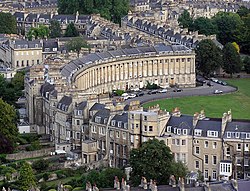 The Royal Crescent in Bath | |
| Location | |
| Grid reference: | ST745645 |
| Location: | 51°22’48"N, 2°21’36"W |
| Data | |
| Population: | 83,992 |
| Post town: | Bath |
| Postcode: | BA1, BA2 |
| Dialling code: | 01225 |
| Local Government | |
| Council: | Bath & NE Somerset |
| Parliamentary constituency: |
Bath |
The City of Bath is in Somerset, a grand city on the River Avon blessed with beautiful buildings from its great age in the Georgian period when it was the favoured fashionable resort, a status it has not entirely lost. Bath is far older though: in the centre of the city is the Roman Bath built on the gushing hot water springs which are its origin and that of its name.
Bath is 13 miles south-east of Bristol. It was granted the title "City" by Queen Elizabeth I in 1590.[1]
The city was first established as a spa with the Latin name, Aquae Sulis ("the waters of Sulis") by the Romans in AD 43, although verbal tradition suggests that Bath was known before then.[2] They built baths and a temple on the surrounding hills of Bath in the valley of the River Avon around natural hot springs.[3]
Bath was a chief city of the realm in the early Middle Ages; the grand coronation of King Edgar I took place here in 973, and at a Witan here in 1086 William the Conqueror ordered the Domesday Survey. Much later, it became popular as a spa town during the Georgian era, which led to a major expansion that left a heritage of exemplary Georgian architecture crafted from Bath Stone.
The City of Bath was inscribed as a World Heritage Site in 1987. The city has a variety of theatres, museums, and other cultural and sporting venues, which have helped to make it a major centre for tourism, with over one million staying visitors and 3.8 million day visitors to the city each year. The city has two universities and several schools and colleges. There is a large service sector, and growing information and communication technologies and creative industries, providing employment for the population of Bath and the surrounding area.
Name of the city
- Latin: Aquae Sulis - the name given by the Romans, meaning "Waters of Sulis" (Sulis being a patron goddess, identified with the Roman Minerva.
- Old English:
Today's, Bath, means simply "bath", a reference to the hot springs and the spa bath to be enjoyed from them.
History
Iron Age and Roman
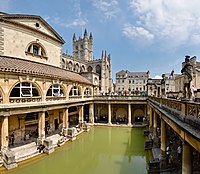
The hills around Bath such as Bathampton Down saw human activity from the Middle Stone Age.[7][8] Several Bronze Age round barrows were opened by John Skinner in the 18th century.[9] Bathampton Camp may have been an Iron Age hill fort or stock enclosure.[10][11] A Long barrow site believed to be from the Beaker culture|Beaker people was flattened to make way for RAF Charmy Down.[12]
Archaeological evidence shows that the site of the Roman Baths' main spring was treated as a shrine by the Iron Age Britons.[13]
Roman Bath
The Romans came here and founded a town based upon the hot springs. The Britons dedicated their shrine to the goddess Sulis, whom the Romans identified with Minerva. Thus the town's Roman name was Aquae Sulis (literally, "the waters of Sulis").[14]
The Roman Bath, uncovered and restored, still receives though it ancient channels, the hot water of the spring and forms a centre-piece of the town. The entire structure above the level of the pillar bases is a later reconstruction, but the bath is original.
The Romans built the temple of Sulis Minerva in AD 60–70 and the bathing complex was gradually built up over the next 300 years.[3]
The first work on the baths was possibly during the reign of the Emperor Claudius, in whose time the Romans had come to Britain.[15] Engineers drove oak piles into the mud to provide a stable foundation and surrounded the spring with an irregular stone chamber lined with lead. In the 2nd century, the spring was enclosed within a wooden barrel-vaulted building,[13] which housed the calidarium (hot bath), tepidarium (warm bath), and frigidarium (cold bath).[16]
The city was given defensive walls, probably in the 3rd century.[17]
Messages to the titulary goddess, Sulis Minerva, have been recovered from the "Sacred Spring" by archaeologists, scratched onto metal.[18] Many are "curse tablets", written in Latin by someone aggrieved and laying a curse on the writer's adversary. One example is by someone whose clothes were stolen at the baths, asking the goddess to punish the thief.
The temple was abandoned when the Empire became Christian, but the baths continued in use. After the failure of Roman authority in the first decade of the 5th century, the baths fell into disrepair and were eventually lost due to silting up.[19]
Anglo-Saxon Period
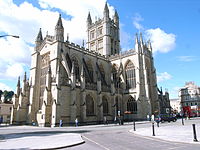
Some claim Bath as the site of a bloody battle between the Britons and the English in about 500, which Gildas calls the siege of Mons Badonicus (he says it was in the year of his birth), and which later legend attributes as a victory of King Arthur, though many places claim the same, and the identification is based on a similarity of the modern name only.[20] The city fell to the West Saxons in 577 after the Battle of Deorham (Dyrham).[21][21]
There is a haunting Old English poem known as The Ruin appears to describe the appearance of the Roman site in this age; the ruin of great works and fallen splendour where once hot baths ran.[22]
A monastery was established in Bath at an early date, probably in 675 by Osric, King of the Hwicce,[23] perhaps using the walled area as its precinct.[24][25] Nennius, a ninth-century historian, mentions a "Hot Lake" in the land of the Hwicce, which was along the Severn, and adds "It is surrounded by a wall, made of brick and stone, and men may go there to bathe at any time, and every man can have the kind of bath he likes. If he wants, it will be a cold bath; and if he wants a hot bath, it will be hot". Bede also describes hot baths in the geographical introduction to the Ecclesiastical History in terms very similar to those of Nennius.[26] King Offa of Mercia gained control of this monastery in 781 and rebuilt the church, which was dedicated to St Peter.[27]
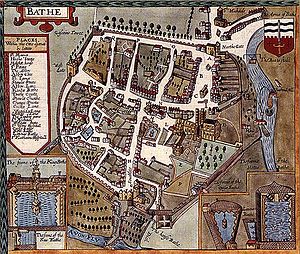
By the 9th century the old Roman street pattern had been lost and Bath had become a royal possession. King Alfred laid the town out afresh, leaving its south-eastern quadrant as the abbey precinct.[28] In the Burghal Hidage Bath is described as having walls of 1,375 yards and was allocated 1,000 men for defence.[29] During the reign of Edward the Elder coins were minted in the town, based on a design from the Winchester mint, with 'BAD' on the obverse.[30]
King Edgar I, "Edgar the Peaceful", 13 years into his reign was crowned in grand ceremony at Bath Abbey in 973.[31]
In 1085, King William I held a council in Bath at which he ordered the survey of the whole kingdom which in 1086 produced the Domesday Book.
Later Middle Ages
King William Rufus granted the city to a royal physician, John of Tours, who became Bishop of Wells and Abbot of Bath,[32][33] following the sacking of the town during the Rebellion of 1088.[34] It was Church policy for bishops to have urban seats, and he translated his own from Wells to Bath.[35] He planned and began a much larger church as his cathedral, to which was attached a priory, with the bishop's palace beside it.[32] New baths were built around the three springs. However, later bishops returned the episcopal seat to Wells, their title changing over the ages but settled eventually as "Bishop of Bath and Wells".
St John's Hospital was founded around 1180, by Bishop Reginald Fitz Jocelin and is among the oldest almshouses in Britain.[36] The 'hospital of the baths' was built beside the hot springs of the Cross Bath, for their health giving properties and to provide shelter for the poor infirm.[37]
The merchants of the town formed guilds to assert their influence, and built the first guildhall probably in the 13th century. Around 1200 the first mayor was also appointed.[38]
Early Modern Bath
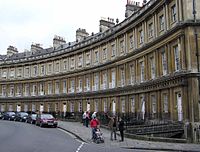
By the 15th century, Bath's abbey church was badly dilapidated and in need of repairs.[39] Oliver King, Bishop of Bath and Wells, decided in 1500 to rebuild it on a smaller scale. The new church was completed just a few years before Bath Priory was dissolved in 1539 by Henry VIII.[40] The abbey church was allowed to become derelict before being restored as the city's parish church in the Elizabethan era, when the city experienced a revival as a spa. The baths were improved and the city began to attract the aristocracy. Bath was granted city status by Queen Elizabeth I in 1590.[1]
During the English Civil War, the city was garrisoned for the King and seven thousand pounds spent on fortifications. However upon the appearance of parliamantary forces the gates were thrown open and the city surrendered, and it then become a significant post in Somerset for the New Model Army under William Waller.[41] It was retaken by royalists following the Battle of Lansdowne which was fought on 5 July 1643 on the northern outskirts of the city.[42]
Thomas Guidott, who had been a student of chemistry and medicine at Wadham College, Oxford, moved to Bath and set up practice in 1668. He became interested in the curative properties of the waters and he wrote A discourse of Bathe, and the hot waters there. Also, Some Enquiries into the Nature of the water in 1676. This brought the health-giving properties of the hot mineral waters to the attention of the country and soon the aristocracy started to arrive to partake in them.[43]
Georgian Bath
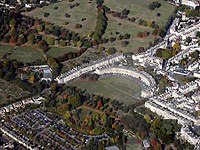
Several areas of the city underwent development during the Stuart period, and this increased during Georgian times in response to the increasing number of visitors to the spa and resort town who required accommodation.[44]
The architects John Wood the Elder and his son John Wood, the Younger laid the new quarters out in streets and squares, the identical façades of which gave an impression of palatial scale and classical decorum.[45] Much of the creamy gold Bath Stone used for construction throughout the city was obtained from the limestone Combe Down and Bathampton Down Mines, which were owned by Ralph Allen (1694–1764).[46] Allen, in order to advertise the quality of his quarried limestone, commissioned the elder John Wood to build him a country house on his Prior Park estate between the city and the mines.[46] He was also responsible for improving and expanding the postal service in western England, for which he held the contract for over forty years.[46] Though not fond of politics, Allen was a civic-minded man, and served as a member of the Bath Corporation for many years. He was elected Mayor of the city for a single term, in 1742, at age 50.[46]
The early 18th century saw Bath acquire its first purpose-built theatre, the Old Orchard Street Theatre, which was rebuilt as the Theatre Royal, the along with the Grand Pump Room attached to the Roman Baths and Bath Assembly Rooms. Master of Ceremonies Beau Nash, who presided over the city's social life from 1705 until his death in 1761, drew up a code of behaviour for public entertainments.[47]
The great works of this time include the Royal Crescent (by John Wood the Younger), the Circus (John Wood the Elder), Lansdown Crescent (John Palmer), the Assembly Rooms (John Wood the Younger), the Pump Room (Thomas Baldwin / John Palmer), Pultney Bridge (Robert Adam), the theatres and much else besides.
This new-built Georgian town was the Bath was that so beloved of Jane Austen and the characters in her books, a connection the town never tires of celebrating:
"Oh! Yes. I shall never be in want of something to talk of again to Mrs. Allen, or anybody else. I really believe I shall always be talking of Bath, when I am at home again — I do like it so very much. If I could but have Papa and Mamma, and the rest of them here, I suppose I should be too happy! James's coming (my eldest brother) is quite delightful — and especially as it turns out that the very family we are just got so intimate with are his intimate friends already. Oh! Who can ever be tired of Bath?"[48]
Late Modern
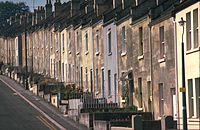
The population of the city had reached 40,020 by the time of the 1801 census, making it one of the largest cities in Britain.[49] William Thomas Beckford bought a house in Lansdown Crescent in 1822, eventually buying a further two houses in the crescent to form his residence. Having acquired all the land between his home and the top of Lansdown Hill, he created a garden over half a mile in length and built Beckford's Tower at the top.[50]
Emperor Haile Selassie I of Ethiopia spent the four years of his exile, from 1936 to 1940, at Fairfield House in Bath.[51]
During Second World War, between the evening of 25 April and the early morning of 27 April 1942, Bath suffered three air raids in reprisal for RAF raids on the German cities of Lübeck and Rostock, part of the Luftwaffe campaign popularly known as the "Baedeker Blitz". Over 400 people were killed, and more than 19,000 buildings were damaged or destroyed.[52] Houses in the Royal Crescent, the Circus and the Paragon were burnt out along with the Assembly Rooms, while part of the south side of Queen Square was destroyed.[53]
A postwar review of inadequate housing led to the clearance and redevelopment of areas of the city in a postwar style, often at variance with the local Georgian style. In the 1950s the nearby villages of Combe Down, Twerton and Weston were incorporated into Bath to enable the development of further housing, much of it council housing. In the 1970s and 1980s it was recognised that conservation of historic buildings was inadequate, leading to more care and reuse of buildings and open spaces. In 1987 the city was selected by UNESCO as a "World Heritage Site", recognising its international cultural significance.[54]
Since 2000, developments have included the Bath Spa, SouthGate and the Bath Western Riverside project.[55]
Geography
Physical geography
Bath is on the River Avon at the bottom of the Avon Valley, and near the southern edge of the Cotswolds, a range of limestone hills designated as an Area of Outstanding Natural Beauty. The hills that surround and make up the city have a maximum altitude of 780 feet on the Lansdown plateau.
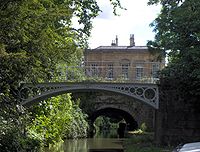
The flood plain of the River Avon, which runs through the centre of the city, has an altitude of about 60 feet above sea level.[56] The river, once an unnavigable series of braided streams broken up by swamps and ponds, has been managed by weirs into a single channel. Nevertheless, periodic flooding, which shortened the life of many buildings in the lowest part of the city, was normal until major flood control works in the 1970s.
The hot springs are at the heart of the city. Water bubbles up from the ground as geothermal springs; the water which falls as rain on the Mendip Hills, percolates down through limestone aquifers to a depth of between 9,000and 14,000 feet, where geothermal energy raises the water temperature to between 64 and 96 °C. Under pressure, the heated water rises to the surface along fissures and faults in the limestone, gushing forth at the baths.
Hot water at a temperature of 46 °C rises here at the rate of 250,000 gallons every day,[57] from a geological fault (the Pennyquick fault).
The Bath springs can be considered the only hot springs in the United Kingdom. Three of these springs feed the thermal baths. In 1983, a new spa water bore-hole was sunk, providing a clean and safe supply of spa water for drinking in the Pump Room.[58]
Culture
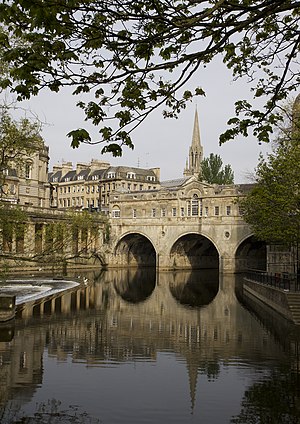
Bath became the leading centre of fashionable life in Britain during the 18th century. It was during this time that Bath's Old Orchard Street Theatre was built, as well as architectural developments such as Lansdown Crescent,[59] the Royal Crescent,[60] The Circus and Pulteney Bridge.[61]
Theatres
Today, Bath has five theatres and attracts internationally renowned companies and directors:
- Bath Theatre Royal
- Ustinov Studio
- the egg
- Rondo Theatre
- Mission Theatre
The city also has a long-standing musical tradition. Bath Abbey is home to the Klais Organ and is the largest concert venue in the city,[62] with about 20 concerts and 26 organ recitals each year.
Another important concert venue is the Forum, a 1,700-seat art deco building which originated as a cinema.
Festivals
The city holds each year:
- The Bath International Music Festival
- Mozartfest
- Bath Film Festival
- Bath Literature Festival (and Bath Festival of Children's Literature
- Bath Fringe Festival and
- Bath Beer Festival
Also:
- The Bach Festivals occur at two and a half year intervals.
An annual competition for the Bard of Bath aims to find Bath's best poet, singer or storyteller. The Bard uses the title to develop artistic projects in the area and leads evening bardic walks around the city.
Museums, galleries and institutions
The city is home to galleries and museums also:
- Roman Baths[63]
- Holburne Museum of Art,[64]
- Bath Postal Museum
- Fashion Museum
- Jane Austen Centre
- Herschel Museum of Astronomy
- Victoria Art Gallery,[65]
- Museum of East Asian Art
Numerous commercial art galleries and antique shops jostle for space among them too.
- The Bath Royal Literary and Scientific Institution, now in Queen Square, was founded in 1824 on the base of a 1777 Society for the encouragement of Agriculture, Planting, Manufactures, Commerce and the Fine Arts, has an important collection and holds a programme of talks and discussions.
Bath in the arts
Artists and photographers
During the 18th century Thomas Gainsborough and Sir Thomas Lawrence lived and worked in Bath.[66][67] John Maggs, a painter best known for his coaching scenes, was born and lived in Bath with his artistic family.[68]
William Friese-Greene began experimenting with celluloid and motion pictures in his studio in Bath in the 1870s, developing some of the earliest movie camera technology there. He is credited as the inventor of cinematography.[69]
Jane Austen
Jane Austen lived in the city from 1801 with her father, mother and sister Cassandra, and the family resided in the city at four successive addresses until 1806.[70] However, Jane Austen never liked the city, and wrote to her sister Cassandra, "It will be two years tomorrow since we left Bath for Clifton, with what happy feelings of escape."[71]
From her works, one would hardly imagine the author's bearing negative thoughts of the city and Bath has honoured her name with the Jane Austen Centre and a city walk. Austen's later Northanger Abbey and Persuasion are largely set in the city and feature descriptions of taking the waters, social life, and music recitals.
Other writers
- The Pickwick Papers by Chalrs Dickens describes the taking the waters, in which Pickwick's servant, Sam Weller, comments that the water has "a very strong flavour o' warm flat irons", while the Royal Crescent is the venue for a chase between two of the characters, Dowler and Winkle.[72]
- The Rivals, the play by Richard Brinsley Sheridan, takes place in the city,[73]
- The Landlady, a chilling short tale by Roald Dahl is set here too.[74]
- The Waters of Sul, a novel by Moyra Caldecott is by contrast set in Roman Bath in 72 AD.
Bath in film and on television
Many films and television programmes have been filmed using the architecture of Bath as the backdrop including:
- Vanity Fair (2004) based on Thackeray's like-named novel
- The Duchess (2008)
- The Elusive Pimpernel (1950)
- The Titfield Thunderbolt (1953)
Parks


The city has several public parks:
Royal Victoria Park is the main park, a short walk from the centre of the city. It was opened in 1830 by an 11-year-old Princess Victoria, later Queen, and was the first park to carry her name.[75] The park is overlooked by the Royal Crescent and is 57 acres in area.[76] Apatr from facilities for leisure, play, open-air concerts, tennis courts, bowling, a putting green and a 12- and 18-hole golf course, much of its area is lawn; a notable feature is the way in which a ha-ha segregates it from the Royal Crescent, while giving the impression to a viewer from the Crescent of a greensward uninterrupted across the Park down to Royal Avenue.
The Botanic Gardens of 9½ acres were formed in 1887 and contain one of the finest collections of limestone-loving plants in the West Country.[77] The replica of a Roman Temple was used at the British Empire Exhibition at Wembley in 1924.[78] In 1987 the gardens were extended to include the Great Dell, a disused quarry that was formally part of the park, which contains a large collection of conifers.
Others include:
- Alexandra Park crowns a hill and overlooks the city
- 'Parade Gardens are along the river front near the Abbey in the centre of the city
- Sydney Gardens were known as a pleasure-garden in the 18th century
- Henrietta Park
- Hedgemead Park
- 'Alice Park
Jane Austen wrote of Sydney Gardens that "It would be pleasant to be near the Sydney Gardens. We could go into the Labyrinth every day."[79] Alexandra, Alice and Henrietta parks were built into the growing city among the housing developments.[80]
There is also a linear park following the old Somerset and Dorset Joint Railway line, and, in a green area adjoining the River Avon.
Food
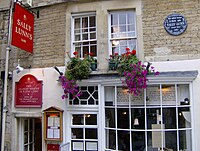
Bath is linked to a variety of foods that are distinctive in their association with the city.
- Sally Lunn buns is a type of teacake, long been baked in Bath. They were first mentioned by that name in verses printed in a local newspaper, the Bath Chronicle, in 1772.[81] At that time they were eaten hot at public breakfasts in the city's Spring Gardens. They can be eaten with sweet or savoury toppings.
- Bath buns, not to be confused with the Sally Lunn, are smaller, round, very sweet, very rich buns that were associated with the city following The Great Exhibition. Bath buns were originally topped with crushed comfits created by dipping caraway seeds repeatedly in boiling sugar; but today seeds are added to a 'London Bath Bun' (a reference to the bun's promotion and sale at the Great Exhibition).[82] The seeds may be replaced by crushed sugar granules or 'nibs'.
- Bath Olivers are a dry baked biscuit invented by Dr William Oliver, physician to the Mineral Water Hospital in 1740.[83] Oliver was an early anti-obesity campaigner and the author of a "Practical Essay on the Use and Abuse of warm Bathing in Gluty Cases".[83] In more recent years, Oliver's efforts have been traduced by the introduction of a version of the biscuit with a plain chocolate coating.
- Bath Chap, is the salted and smoked cheek and jawbones of the pig, takes its name from the city.[84] It is still available from a stall in the daily covered market.
Tourism and architecture
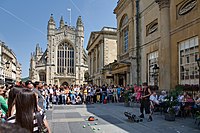
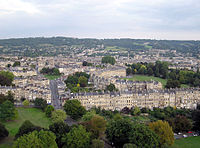
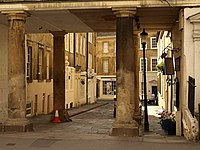
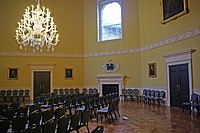
One of Bath's principal industries is tourism: it has more than one million staying visitors and 3.8 million day visitors to the city each year.
All significant stages of the history of Britain are represented within the city, from the Roman Baths through mediæval Bath Abbey to the Georgian Royal Crescent and Thermae Bath Spa in the 2000s. The history of the city is displayed at the Building of Bath Collection, housed in the former Trinity Presbyterian Church founded in 1765. The city has about 100 restaurants and a similar number of pubs and bars to feed and water the army of visitors. The one modern attraction is the Thermae Bath Spa, the city's attempt to recapture its historical position as the only town in the United Kingdom offering visitors the opportunity to bathe in naturally heated spring waters.
The Royal Crescent is reckoned one of Britain's most picturesque streets, and Milsom Street argued to be Britain's best fashion street.[85]
The Roman Baths are the foremost of the archaeological sites in the city centre representing that period. They are reconstructed above the leve of the baths theselves but the most important parts of the baths are original.
Bath Abbey was a Norman church built on earlier foundations, though the present church is early 16th century. The walls of Bath Abbey are crammed full with memorials to those of the gentry who came to Bath for a cure, and who are buried here.
Georgian architecture is dominant in central Bath, built of honey-colorued Bath Stone hewn from local hills. Many of the prominent architects of the day were employed in the development of the city. The original purpose of much of Bath's architecture is concealed by the honey-coloured classical façades; in an era before the advent of the luxury hotel, these apparently elegant residences were frequently purpose-built lodging houses, where visitors could hire a room, a floor, or (according to their means) an entire house for the duration of their visit, and be waited on by the house's communal servants.[86]
The Circus consists of three long, curved terraces designed by John Wood the Elder to form a circular space intended for civic functions and games, the design inspired by the Colosseum in Rome.[87] Like the Colosseum, the three façades have a different order of architecture on each floor: Doric on the ground level, then Ionic on the piano nobile and finishing with Corinthian on the upper floor, the style of the building thus becoming progressively more ornate as it rises.[87] Wood never lived to see his unique example of town planning completed, as he died five days after personally laying the foundation stone on 18 May 1754.[87]
The Royal Crescent is the most spectacular of Bath's terraces, built between 1767 and 1774 by John Wood, the Younger.[88] The front is completely uniform and beautifully symmetrical, but the rear is a mixture of differing roof heights, juxtapositions and fenestration, as the individual owners built in their own way behind Wood's frontage.
Other fine terraces elsewhere in the city include Lansdown Crescent and Somerset Place on the northern hill.
Pulteney Bridge was built around 1770 by Robert Adam in the neoclassical style from an unused design by Palladio.[89] It became not just a means of crossing the river, but also a shopping arcade. The bridge was named after Frances and Sir William Pulteney, the owners of the Bathwick estate for which the bridge provided a link to the rest of Bath.[89]
The Pump Room was the heart of the Georgian city, where the waters were taken. Together with its associated Lower Assembly Rooms, it was designed by Thomas Baldwin. Baldwin rose rapidly, becoming a leader in Bath's architectural history. In 1776 he was made the chief City Surveyor, and in 1780 became Bath City Architect. Great Pulteney Street, where he eventually lived, is another of his works: this wide boulevard, constructed around 1789 and over 1,000 feet long and 100 feet wide, is lined on both sides by Georgian terraces.
In the 1960s and early 1970s some parts of Bath were unsympathetically redeveloped, destroying some 18th- and 19th-century buildings, a process mercifully restrained by a popular campaign which drew strength from the publication of Adam Fergusson's The Sack of Bath,[90] though the threat from enthusiasts for concrete modernity yet remains.

Outside links
- Visit Bath: tourist information
| World Heritage Sites in the United Kingdom |
|---|
|
Bath • Blaenavon Industrial Landscape • Blenheim Palace • Canterbury Cathedral, St Augustine's Abbey & St. Martin's Church • Castles and Town Walls of King Edward I • Cornwall and West Devon Mining Landscape • Derwent Valley Mills • Durham Castle & Cathedral • Edinburgh Old Town & New Town • Forth Bridge • Frontiers of the Roman Empire: Antonine Wall & Hadrian's Wall • Giant's Causeway • Ironbridge Gorge • Jurassic Coast • Kew Gardens • Liverpool Maritime Mercantile City • Maritime Greenwich • New Lanark • Heart of Neolithic Orkney • Pontcysyllte Aqueduct • St Kilda • Saltaire • Stonehenge, Avebury & Associated Sites • Studley Royal Park & Fountains Abbey • Tower of London • Palace of Westminster, Westminster Abbey & St Margaret's Church |
References
- ↑ 1.0 1.1 "Civic Insignia". City of Bath. http://www.thecityofbath.co.uk/civic_insignia.htm. Retrieved 10 December 2007.
- ↑ "History of Bath's Spa". Bath Tourism Plus. http://visitbath.co.uk/site/spa-and-wellbeing/history-of-baths-spa. Retrieved 25 January 2011.
- ↑ 3.0 3.1 "City of Bath World Heritage Site Management Plan". Bath and North East Somerset. Archived from the original on 14 June 2007. http://web.archive.org/web/20070614100836/http://www.bathnes.gov.uk/worldheritage/2.3Des.htm. Retrieved 1 November 2007.
- ↑ Anglo-Saxon Chronicle (972 Chronicle) (Laud) Her wæs Eadgar eþeling gehalgod to cyninge on Pentecoste mæssedæi on v idus Mai. þe xiii geare þe he to rice feng. æt Hatabaðum
- ↑ Anglo-Saxon Chronicle (972 Chronicle) (Parker) Her Eadgar wæs, Engla waldend, corðre micelre to cyninge gehalgod on ðære ealdan byrig, Acemannesceastre
- ↑ E.g. Anglo-Saxon Chronicle (1013 Chronicle) (Laud) Þa wende Swegen cyning þanon to Wealingaforda. 7 swa ofer Temese westweard to Baðon
- ↑ Wessex Archaeology. "Archaeological Desk- based Assessment". University Of Bath, Masterplan Development Proposal 2008. Bath University. http://www.bath.ac.uk/masterplan/documents/AppendixF.pdf.
- ↑ "Monument No. 204162". Pastscape National Monuments Record. English Heritage. http://www.pastscape.org.uk/hob.aspx?hob_id=204162. Retrieved 29 May 2011.
- ↑ Thomas, Rod (2008). A Sacred landscape: The prehistory of Bathampton Down. Bath: Millstream Books. p. 21. ISBN 9780948975868.
- ↑ Thomas, Rod (2008). A Sacred landscape: The prehistory of Bathampton Down. Bath: Millstream Books. pp. 46–48. ISBN 9780948975868.
- ↑ "Bathampton Camp". Pastscape National Monuments Record. English Heritage. http://www.pastscape.org.uk/hob.aspx?hob_id=203244. Retrieved 10 May 2011.
- ↑ "The Beaker people and the Bronze Age". Somerset County Council. http://www1.somerset.gov.uk/archives/ASH/Beakpeop.htm. Retrieved 22 January 2011.
- ↑ 13.0 13.1 "The Roman Baths". Somerset Tourist Guide. http://www.somersettouristguide.com/Bath/The_Roman_Baths_722.asp. Retrieved 1 November 2007.
- ↑ A L Rowse, Heritage of Britain, 1995, Treasure of London, ISBN 978-0-907407-58-4, 184 pages, Page 15
- ↑ "The History of Plumbing — Roman and English Legacy". Plumbing World. http://www.plumbingworld.com/historyroman.html. Retrieved 1 November 2007.
- ↑ "The Roman Baths". TimeTravel Britain. http://www.timetravel-britain.com/articles/stones/romanbaths.shtml. Retrieved 21 November 2009.
- ↑ "Alfreds Borough". Bath Past. http://www.buildinghistory.org/bath/saxon/alfredsborough.shtml. Retrieved 12 December 2007.
- ↑ "A Corpus of Writing-Tablets from Roman Britain". Centre for the Study of Ancient Documents, Oxford. http://www.csad.ox.ac.uk/RIB/RIBIV/jp4.htm. Retrieved 8 December 2007.
- ↑ "The Roman Baths". BirminghamUk.com. http://www.birminghamuk.com/romanbaths.htm. Retrieved 1 November 2007.
- ↑ "Dobunni to Hwicce". Bath past. http://www.buildinghistory.org/bath/saxon/dobunni.shtml#Gildas. Retrieved 8 December 2007.
- ↑ 21.0 21.1 "History of bath england, roman bath history". My England Travel Guide. http://www.myenglandtravel.com/history-of-bath-england.html. Retrieved 8 December 2007.
- ↑ Klinck, Anne (1992). The Old English Elegies: A Critical Edition and Genre Study. Montreal: McGill-Queen's University Press. p. 61.
- ↑ Davenport, Peter (2002). Mediæval Bath Uncovered. Stroud: Tempus. pp. 31–34. ISBN 075241965x.
- ↑ "Timeline Bath". Time Travel Britain. http://www.timetravel-britain.com/articles/towns/bathtime.shtml. Retrieved 21 November 2009.
- ↑ "Saint David". 100 Welsh Heroes. http://www.100welshheroes.com/en/biography/saint%20david. Retrieved 19 March 2011.
- ↑ Campbell et al., The Anglo-Saxons, pp. 40–41.
- ↑ "Bath Abbey". Robert Poliquin's Music and Musicians. Quebec University. http://www.uquebec.ca/musique/orgues/angleterre/batha.html#English. Retrieved 18 September 2007.
- ↑ "Alfreds Borough". Bath Past. http://www.buildinghistory.org/bath/saxon/alfredsborough.shtml. Retrieved 8 December 2007.
- ↑ Davenport, Peter (2002). Mediæval Bath Uncovered. Stroud: Tempus. pp. 40–42. ISBN 075241965x.
- ↑ Davenport, Peter (2002). Mediæval Bath Uncovered. Stroud: Tempus. pp. 50–51. ISBN 075241965x.
- ↑ "Edgar the Peaceful". English Monarchs – Kings and Queens of England. http://www.englishmonarchs.co.uk/saxon_12.htm. Retrieved 8 December 2007.
- ↑ 32.0 32.1 Powicke, Maurice (1939). Handbook of British Chronology. ISBN 978-0-901050-17-5.
- ↑ Barlow, Frank (March 2000). William Rufus. Yale University Press. p. 182. ISBN 978-0-300-08291-3.
- ↑ Davenport, Peter (2002). Mediæval Bath Uncovered. Stroud: Tempus. p. 71. ISBN 075241965x.
- ↑ Huscroft Ruling England p. 128
- ↑ "The eight-hundred-year story of St John's Hospital, Bath". Spirit of Care. Jean Manco. http://www.buildinghistory.org/jean/spiritofcare.shtml. Retrieved 2009-07-25.
- ↑ Manco, Jean. "Shelter in old age". Bath Past. http://www.buildinghistory.org/bath/mediæval/shelter.shtml. Retrieved 2009-07-25.
- ↑ Davenport, Peter (2002). Mediæval Bath Uncovered. Stroud: Tempus. pp. 97–98. ISBN 075241965x.
- ↑ "Bath Abbey". Visit Bath. http://visitbath.co.uk/site/things_to_do/p_24001. Retrieved 10 December 2007.
- ↑ "Renaissance Bath". City of Bath. http://www.thecityofbath.co.uk/renaissance_bath.htm. Retrieved 9 December 2007.
- ↑ Crutwell, Clement (1801). A tour through the whole island of Great Britain; Divided into Journeys. Interspersed with Useful Observations; Particularly Calculated for the Use of Those who are Desirous of Travelling over England & Scotland. 2. http://books.google.co.uk/books?id=7n5HAAAAYAAJ&pg=PA387.
- ↑ Rodgers, Colonel H.C.B. (1968). Battles and Generals of the Civil Wars. Seeley Service & Co..
- ↑ Burns, D. Thorburn (1981). "Thomas Guidott (1638–1705): Physician and Chymist, contributor to the analysis of mineral waters". Analytical Proceedings including Analytical Communications: Royal Society of Chemistry 18 (1): 2–6. doi:10.1039/AP9811800002. http://www.rsc.org/publishing/journals/article.asp?doi=AP9811800002. Retrieved 10 December 2007.
- ↑ Hembury, Phylis May (1990). The English Spa, 1560–1815: A Social History. Fairleigh Dickinson Univ. Press. ISBN 978-0-8386-3391-5.
- ↑ "John Wood and the Creation of Georgian Bath". Building of Bath Museum. http://www.bathmuseum.co.uk/biography.htm. Retrieved 8 December 2007.
- ↑ 46.0 46.1 46.2 46.3 "Ralph Allen Biography". Bath Postal Museum. http://www.bathpostalmuseum.co.uk/explore/biographies/ralphallen.html. Retrieved 8 December 2007.
- ↑ Eglin, John (2005). The Imaginary Autocrat: Beau Nash and the invention of Bath. Profile. ISBN 978-1-86197-302-3.
- ↑ Northanger Abbey, Chap 10 (Jane Austen)
- ↑ "A vision of Bath". Britain through time. http://www.visionofbritain.org.uk/unit_page.jsp?u_id=10167607. Retrieved 8 December 2007.
- ↑ "Beckford's Tower & Mortuary Chapel, Lansdown Cemetery". Images of England. http://www.imagesofengland.org.uk/Details/Default.aspx?id=442844. Retrieved 2 October 2007.
- ↑ "The Emperor Haile Selassie I in Bath 1936–1940". Anglo-Ethiopian Society. http://anglo-ethiopian.org/publications/articles.php?type=O&reference=publications/occasionalpapers/papers/haileselassiebath.php. Retrieved 8 December 2007.
- ↑ "History — Bath at War". Royal Crescent Society, Bath. Archived from the original on 19 May 2007. http://web.archive.org/web/20070519191111/http%3A//www.royalcrescentbath.com/HistoryBathatWar.htm. Retrieved 9 December 2007.
- ↑ "Royal Crescent History: The Day Bombs fell on Bath". Royal Crescent Society, Bath. Archived from the original on 31 January 2008. http://web.archive.org/web/20080131165322/http%3A//www.royalcrescentbath.com/HistoryRoyalCrescent%25202.htm. Retrieved 9 December 2007.
- ↑ "Bath – World Heritage Site". Bath & North East Somerset Council. http://www.bathnes.gov.uk/environmentandplanning/worldheritagesite/Pages/default.aspx. Retrieved 25 January 2011.
- ↑ "South Gate Bath". Morley. http://www.southgatebath.com. Retrieved 8 December 2007.
- ↑ Bath Western Riverside Outline Planning Application Design Statement, April 2006, Section 2.0, Site Analysis
- ↑ "Sacred Spring". Roman Baths Museum Web Site. http://www.romanbaths.co.uk/index.cfm?fuseAction=SM.nav&UUID=F9F320C4-1A95-4C04-AC609094E5B5DFD3. Retrieved 31 October 2007.
- ↑ "Hot Water". Roman Baths Museum Web Site. http://www.romanbaths.co.uk/index.cfm?fuseAction=SM.nav&UUID=4B6F21CE-7CF4-4283-AF5C03FB05527814. Retrieved 31 October 2007.
- ↑ "1 to 20 Lansdown Crescent". Images of England. http://www.imagesofengland.org.uk/Details/Default.aspx?id=442760. Retrieved 14 November 2006.
- ↑ "Royal Crescent". Images of England. http://www.imagesofengland.org.uk/Details/Default.aspx?id=443488. Retrieved 14 November 2006.
- ↑ "Pulteney Bridge". Images of England. http://www.imagesofengland.org.uk/Details/Default.aspx?id=443316. Retrieved 14 November 2006.
- ↑ "Abbey Church". Images of England. http://www.imagesofengland.org.uk/Details/Default.aspx?id=442109. Retrieved 14 November 2006.
- ↑ "Roman Baths Treatment Centre". Images of England. http://www.imagesofengland.org.uk/Details/Default.aspx?id=442194. Retrieved 15 November 2006.
- ↑ "Holburne of Menstrie Museum". Images of England. http://www.imagesofengland.org.uk/Details/Default.aspx?id=443742. Retrieved 15 November 2006.
- ↑ "Victoria Art Gallery". Images of England. http://www.imagesofengland.org.uk/Details/Default.aspx?id=442375. Retrieved 15 November 2006.
- ↑ "Thomas Gainsborough". The Artchive. http://www.artchive.com/artchive/G/gainsborough.html. Retrieved 9 December 2007.
- ↑ "Artists Illustrating Boys' Fashions: Sir Thomas Lawrence (England, 1769–1830):". Historical Boys Clothing. http://www.histclo.com/art/artist-law.html. Retrieved 9 December 2007.
- ↑ "John Maggs". Art History Club. http://www.arthistoryclub.com/art_history/John_Maggs. Retrieved 27 March 2009.
- ↑ "William Friese Greene". Whos Who of Victorian Cinema. http://www.victorian-cinema.net/friesegreene.htm. Retrieved 9 December 2007.
- ↑ "Jane Austen Centre". Jane Austen Centre. http://www.janeausten.co.uk/. Retrieved 8 December 2007.
- ↑ David, David (1998). Jane Austen: A Life. University of California Press. ISBN 978-0-520-21606-8.
- ↑ "The Pickwick Papers". Complete works of Charles Dickens. http://www.dickens-literature.com/The_Pickwick_Papers/. Retrieved 10 December 2007.
- ↑ "The Rivals: A synopsis of the play by Richard Brinsley Sheridan". Theatre History.com. http://www.theatrehistory.com/irish/rivals.html. Retrieved 10 December 2007.
- ↑ "The Landlady by Roald Dahl" (PDF). Teaching English. http://www.teachingenglish.org.uk/try/britlit/landlady. Retrieved 21 November 2009.
- ↑ "Visit Bath & Beyond"
- ↑ "Victoria Park". City of Bath. http://www.cityofbath.co.uk/Parks_rec/vicpark.html. Retrieved 9 December 2007.
- ↑ measurement given in acres
- ↑ "Playing in the park". BBC Bristol. http://www.bbc.co.uk/bristol/content/articles/2007/06/27/royal_victoria_park_feature.shtml. Retrieved 10 November 2007.
- ↑ Hill, Constance (1901). Jane Austen: Her homes & her friends. John Lane. Dodley Head Ltd.
- ↑ "Local parks and gardens". Avon Gardens Trust. http://avongardenstrust.50webs.com/index.html. Retrieved 21 November 2009.
- ↑ "History of Sally Lunn Cake". Whats cooking America. http://whatscookingamerica.net/History/Cakes/SallyLunnCake.htm. Retrieved 10 December 2007.
- ↑ Davidson, Alan (1999). Oxford Companion to Food p 114. Oxford: Oxford University Press. ISBN 978-0-19-211579-9.
- ↑ 83.0 83.1 "Dr William Oliver, Bath Oliver Biscuit Inventor". Cornwall calling. http://www.cornwall-calling.co.uk/famous-cornish-people/oliver.htm. Retrieved 9 December 2007.
- ↑ "Bath chap". A Dictionary of Food and Nutrition, Oxford University Press. http://www.encyclopedia.com/doc/1O39-Bathchap.html. Retrieved 9 December 2007.
- ↑ "The Shambles, York, named Britain's 'most picturesque'". BBC News. 8 March 2010. http://news.bbc.co.uk/1/hi/uk/8554388.stm. Retrieved 8 March 2010.
- ↑ David, Graham (2000). Social Decline and Slum Conditions: Irish migrants in Bath's History.
- ↑ 87.0 87.1 87.2 Gadd, David (1987). Georgian Summer. Countryside Books.
- ↑ "Royal Crescent". Images of England. http://www.imagesofengland.org.uk/Details/Default.aspx?id=447275. Retrieved 14 November 2006.
- ↑ 89.0 89.1 Manco, Jean (1995). Pulteney Bridge. 38. SAHGB Publications Limited. 129–145. doi:10.2307/1568625.
- ↑ Borsay, Peter (2000). The Image of Georgian Bath, 1700–2000: Towns, Heritage, and History. Oxford University Press. ISBN 978-0-19-820265-3.
| Cities in the United Kingdom |
|---|
|
Aberdeen • Armagh • Bangor (Caernarfonshire) • Bangor (County Down) • Bath • Belfast • Birmingham • Bradford • Brighton and Hove • Bristol • Cambridge • Canterbury • Cardiff • Carlisle • Chelmsford • Chester • Chichester • Colchester • Coventry • Derby • Doncaster • Dundee • Dunfermline • Durham • Ely • Edinburgh • Exeter • Glasgow • Gloucester • Hereford • Inverness • Kingston upon Hull • Lancaster • Leeds • Leicester • Lichfield • Lincoln • Lisburn • Liverpool • City of London • Londonderry • Manchester • Milton Keynes • Newcastle upon Tyne • Newport • Newry • Norwich • Nottingham • Oxford • Perth • Peterborough • Plymouth • Portsmouth • Preston • Ripon • Rochester • Salford • Salisbury • Sheffield • Southampton • St Albans • St Asaph • St David's • Southend-on-Sea • Stirling • Stoke-on-Trent • Sunderland • Swansea • Truro • Wakefield • Wells • Westminster • Winchester • Wolverhampton • Worcester • Wrexham • York |